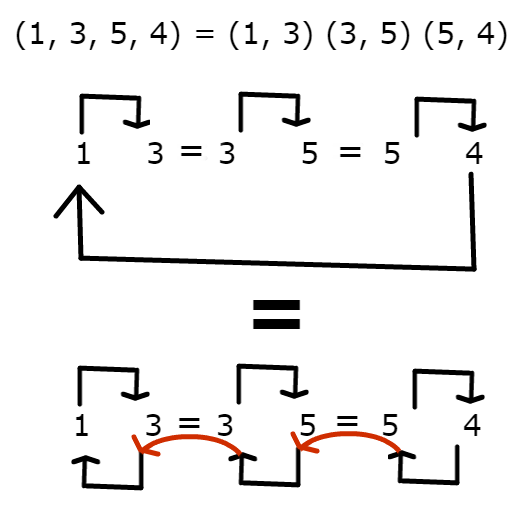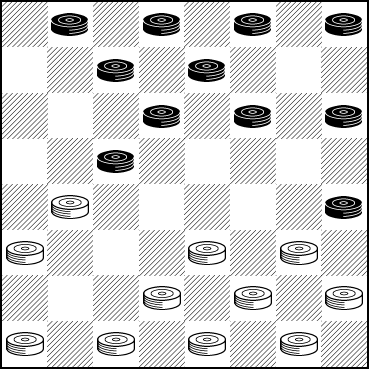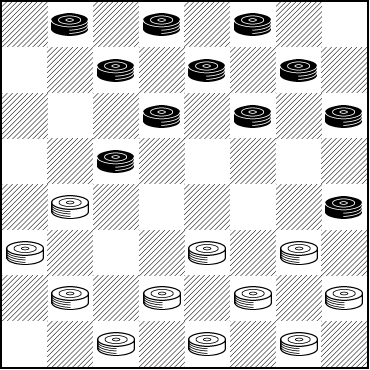Transpositions

There are transpositions in music; music in one key is transposed into another. It's something that's familiar to all music students.

There are also transpositions in mathematics; the one shown above is from the branch of study known as group theory. We won't try to explain it here as it's more than a bit out of scope for a checker column.
What is in scope of course, is a transposition in a checker game. Transpositions are common in the openings, when one opening line, whether through a different order of moves or other means, transposes, or changes, into another opening line. (The concept can of course be generalized beyond openings.)

Jim Loy has put together a comprehensive booklet of opening transitions, and has generously offered it for free publication on our Checker Maven website. You can download the book here.
As an example, and today's problem, here's a landing known as the Pioneer, which can be reached by transposition from six different ballots.
BLACK

WHITE
White to Play
W:W17,21,23,24,26,27,28,29,30,31,32:B1,2,3,4,6,7,10,11,12,14,20
White now plays 29-25. If Black follows with 4-8, he falls into a losing position known as Dunne's Loss, as shown below.
BLACK

WHITE
White to Play and Win
W:W17,21,23,24,25,26,27,28,30,31,32:B1,2,3,6,7,8,10,11,12,14,20
What should Black have played instead?
Your task is to correct the losing move (not so hard) and to work out the White win, rather an advanced challenge, but instructive nonetheless. So see how well you can do, then click on Read More to see the winning play.![]()
Solution
As we said, this one is quite advanced. We show one of the six run-ups and one possible solution. You can explore variations with your computer.
| 1. | 9-14 | 22-17 |
| 2. | 11-16 | 25-22 |
| 3. | 8-11 | 22-18 |
| 4. | 16-20 | 18x9 |
| 5. | 5x14 | ... |
Forms Pioneer Landing.
| 5. | ... | 29-25 |
| 6. | 4-8 | ... |
Forms problem diagram. 11-15 would have been the correct move. Note how subtle the difference is between a losing move and one that would have held the draw. What's going on here? Look below. After White plays 25-22 Black can no longer play 11-15 lest he fall into a three for one shot via 23-18. The Black man on 8 rather than 4 makes this possible. So Black plays 11-16 instead and dies slowly.
| 6. | ... | 25-22 |
| 7. | 11-16 | 24-19 |
| 8. | 8-11 | 22-18 |
| 9. | 1-5 | 18x9 |
| 10. | 5x14 | 26-22 |
| 11. | 11-15 | 30-25 |
| 12. | 15x24 | 28x19 |
| 13. | 7-11 | 17-13 |
| 14. | 11-15 | 22-17 |
| 15. | 15x24 | 23-19 |
| 16. | 16x23 | 27x9 |
| 17. | 10-15 | 25-22 |
| 18. | 3-8 | 9-5 |
| 19. | 6-9 | 13x6 |
| 20. | 2x9 | 5-1 |
The White Win is clearly visible.
| 21. | 9-13 | 1-6 |
| 22. | 15-19 | 6-10 |
| 23. | 8-11 | 31-26 |
| 24. | 24-28 | 17-14 |
| 25. | 19-24 | 22-18 |
| 26. | 11-16 | 10-15 |
| 27. | 16-19 | 14-9 |
| 28. | 12-16 | 9-6 |
White Wins. Black is out of moves.
You can email the Webmaster with comments on this article.